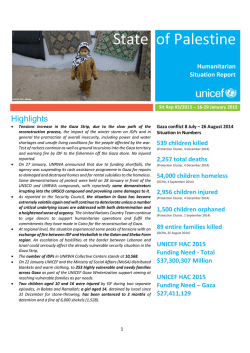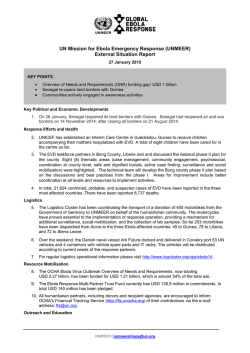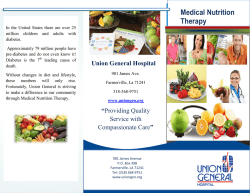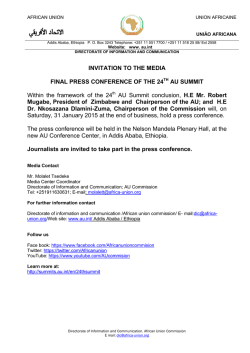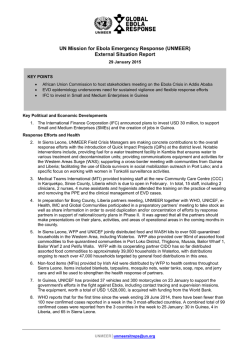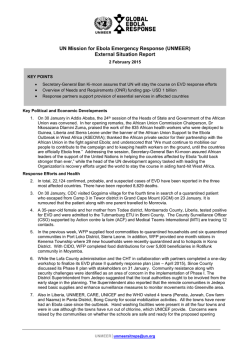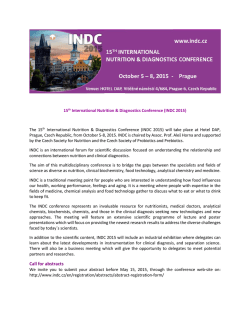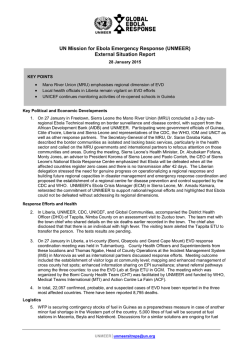
Current appeal [PDF]
2015 ©UNICEF Ethiopia/2014/Aslanyan Humanitarian Action for Children Total affected population: 3.2 million Ethiopia Total affected children (under age 18): 1.2 million Due to the overall poor performance of the 2014 seasonal rains in parts of Somali, Afar, Southern Nations, Nationalities and Peoples' (SNNP) and Oromia regions, the number of Ethiopians in need of emergency food assistance increased from 2.7 million at the beginning of 2014 to 3.2 million by mid-year1. From January to September 2014, 194,697 severely malnourished children were treated in Ethiopia, a 6.2 per cent decrease from the same period in 20132. In total, UNICEF estimates that some 264,298 severely malnourished children required treatment in 2014. Since the outbreak of the conflict in South Sudan in December 2013, over 193,649 South Sudanese refugees have fled the violence to Ethiopia, with an estimated 40,000 additional refugees, mostly women and children, seeking protection in Ethiopia by December 20143. The health and nutrition situation of newly arrived South Sudanese refugee children is of particular concern, with the July 2014 nutrition survey showing that nearly 28 per cent of those under 5 are acutely malnourished in Gambella refugee camps. By October 2014, 643,010 refugees from South Sudan (39 per cent), Somalia (38 per cent), Eritrea (17 per cent), and Sudan (6 per cent) were residing in Ethiopia and in need of assistance and protection4. UNICEF and partners are planning for an additional 110,000 new refugees from South Sudan in 2015. Humanitarian strategy In 2015, UNICEF will continue to work with the Government of Ethiopia and partners in supporting humanitarian action, ensuring children affected by crises have adequate access to education, health and nutrition care, safe water, sanitation and hygiene facilities, and that they receive protection support. UNICEF will support community-level and systems resilience building interventions that reduce the vulnerability of women and children in Ethiopia. In the remote and emergencyaffected areas of Somali and Afar regions, UNICEF will support mobile health and nutrition teams to provide access to basic essential health services. UNICEF will collaborate with WHO and partners to provide support to the Federal Ministry of Health (FMoH) in the prevention and control of disease outbreaks, including in Ebolapreparedness. UNICEF will support the treatment of children suffering from severe acute malnutrition through government-led community-based management of acute malnutrition. UNICEF aims to reach people with sanitation and hygiene information, and support the establishment and rehabilitation of water sources to prevent child illnesses. UNICEF will facilitate 1 continued education for children affected by emergencies. In child protection, UNICEF will bolster community-based social protection structures to strengthen the traditional care and support systems of local communities. UNICEF will facilitate sector coordination as the cluster lead in nutrition and WASH and co-lead in education and child protection. For refugee response, UNICEF will work closely with UNHCR and the Government to deliver lifesaving interventions to refugees and host communities, across the various sectors. UNICEF will continue to support the empowerment of government institutions and communities to enhance their resilience to multiple and recurrent shocks. Results from 2014 UNICEF originally appealed for US$36,086,000, and later revised requirements to US$42,311,000 to reflect the additional resources needed for the South Sudan refugee crisis. As of mid-November 2014, a total of US$25,009,504, or 60 per cent of the revised requirements, were available from various donors. In 2014, UNICEF Ethiopia worked with partners to respond to emergencies and to build the resilience of communities and public Ethiopia Humanitarian Requirement Document, September 2014 2 Emergency Nutrition Coordination Unit and UNICEF Monthly Reports 3 UNHCR Fact Sheet Update, October 2014 4 Ibid Total people to be reached in 2015: 1.8 million Total children to be reached in 2015: 1 million 2015 Programme Targets Nutrition 260,000 children under 5 affected by severe acute malnutrition treated 2,450,000 children under 5 screened and referred to supplementary feeding programme. 580,000 pregnant and breastfeeding women screened and referred to supplementary feeding programme Health 350,000 children and women access essential health services though preventive and curative interventions in Somali and Afar regions Populations affected by disease outbreaks access lifesaving curative and preventive interventions 108,000 refugee children vaccinated against measles WASH 850,000 people have access to safe water for drinking, cooking and personal hygiene 1,140,000 emergency-affected people receive sanitation and hygiene information to prevent child illnesses Child Protection 50,000 children in humanitarian situations vulnerable to violence, exploitation and abuse accessing appropriate care and services 5,000 separated/unaccompanied children reunited with their families or provided with appropriate alternative care Education 120,000 children in emergencyaffected areas access temporary learning spaces and basic education materials www.unicef.org/appeals/ethiopia service systems, providing cluster leadership in WASH and nutrition, and co-leadership in the education and child protection clusters. UNICEF also provided technical support to the disaster prevention and preparedness bureaus in Afar, Amhara, Gambella, Oromia, Somali, SNNP and Tigray regions on regional emergency preparedness and response plans for 2014. In 2014, UNICEF's humanitarian interventions in several sectors, including WASH, Health, and Child Protection, reached more people than initially planned due to a high influx of South Sudanese refugees and an extension of the UNICEF emergency response to address the needs of the vulnerable host community in Gambella region of Ethiopia. UNICEF supported the Ministry of Health and NGO partners in the management of severe acute malnutrition reaching 194,697 children with treatment through the provision of therapeutic food, drugs and equipment to more than 12,000 therapeutic feeding sites in the country. UNICEF has continued to support community-based nutrition interventions to build food security and nutrition resilience jointly with WFP, FAO and other UN agencies. To assist the Somali and Afar regional health bureaus’ programmes for hard-toreach communities, UNICEF provided 152 emergency drug kits to mobile health and nutrition teams, sufficient to meet for the various medical needs of more than 200,000 people. UNICEF supported the implementation of the emergency water response through a joint action plan by all sector partners in Afar and Somali regions. An estimated 116,000 children affected by emergencies were able to continue their education partly due to the supplies UNICEF provided, including 150 early childhood development kits, 300 teacher kits and 200 learner kits. An estimated 50 per cent of the resources mobilized in 2014 were in response to the South Sudan refuge crisis in Gambella. The UNICEF-UNHCR partnership continued to deliver results for refugee children particularly in Gambella and Shire. In Shire, UNHCR and UNICEF are providing interventions for the large number of unaccompanied and separated children. UNICEF seconded technical staff in WASH, nutrition, health, child protection and education sectors to work with UNHCR in support of the South Sudanese refugee response. Other UNICEF responses for the South Sudanese refugees included: support to 30,000 children ensuring they could access primary education; scaling up nutrition interventions in the refugee camps and host communities; provision of essential drugs for primary health care; deployment of three mobile health and nutrition teams at entry points; and strengthening child protection mechanisms in the camps. UNICEF has also been supporting the Government of Ethiopia with its Ebola preparedness plan. 2014 PROGRAMME TARGETS AND RESULTS Cluster 2014 Targets Cluster 2014 Results UNICEF 2014 Targets UNICEF 2014 Results NUTRITION Children under 5 with severe acute malnutrition treated Children under 5 and pregnant and breastfeeding women screened and referred to supplementary feeding programme Refugee children ages 6 to 59 months received vitamin A supplementation HEALTH Children and women have sustained access to essential health services for high-impact preventive and curative interventions (consultations provided by mobile health teams) Refugee and host community children vaccinated against measles WATER, SANITATION & HYGIENE People in humanitarian situations accessing water for drinking, cooking and personal hygiene Children and women receive critical WASH-related information to prevent child illness, especially diarrhoea CHILD PROTECTION Children in humanitarian situations vulnerable to violence, exploitation and abuse accessing appropriate care and services Identified separated and unaccompanied children reunited with their families/caregivers or provided with an appropriate alternative care EDUCATION Children in humanitarian situations accessing formal and nonformal education 238,700 194,697 238,700 194,697 2,600,000 2,700,000 2,600,000 2,700,000 64,400 67,000 533,000 204,974 175,000 177,393 1,029,091 925,595 617,455 699,072 1,900,000 1,100,000 1,140,000 775,000 36,000 38,700 2,500 2,700 135,000 116,000 300,000 150,661 Nutrition data are from January to September 2014; Health data are from January to August 2014; All other data are as of October 2014, unless otherwise noted. www.unicef.org/appeals/ethiopia Funding requirements In 2015, UNICEF will require US$36,200,000 to meet the humanitarian needs of children and to build capacities at local and national levels to enhance resilience to recurrent shocks. The funding requirement includes US$13,800,000 for UNICEF support to the South Sudan refugee crisis. Without timely funding in 2015, women and children facing food insecurity, drought, floods and displacement will not receive adequate assistance to fulfil their basic needs and realize their rights. 2015 Requirements (US$) Sector 10,000,0005 Nutrition Health 8,600,000 Water, Sanitation & Hygiene 8,500,000 Child Protection 3,000,000 Education 4,500,000 Cluster/Sector Coordination 1,600,000 Total 36,200,000 5 The total requirement for emergency nutrition response in 2015 is US$21 million of which US$11 million is already funded through multi-year grants provided by DFID and the Government of Canada. For further information please contact: Anupama Rao Singh Representative, a.i, UNICEF Ethiopia Country Office Tel: +251 11518 4003 Email: [email protected] Yasmin Haque Deputy Director, Office of Emergency Programmes (EMOPS) UNICEF, New York Tel: +1 212 326 7150 Email: [email protected] Olav Kjørven Director, Public Partnerships Division (PPD) UNICEF, New York Tel: +1 212 326 7160 Email: [email protected]
© Copyright 2024
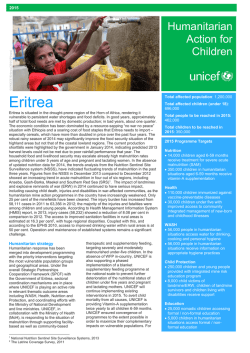
![Current appeal [PDF]](http://s2.esdocs.com/store/data/000476858_1-ff5bfc045afda14d4551c905d8c862b7-250x500.png)
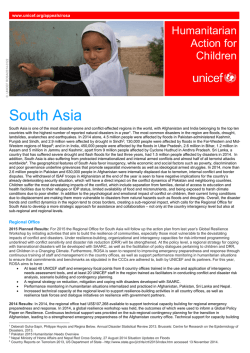
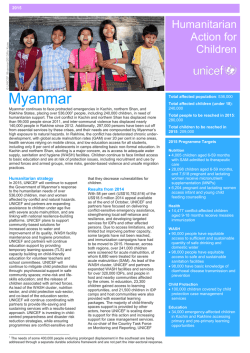
![Current appeal [PDF]](http://s2.esdocs.com/store/data/000456387_1-84443a4282546a8fcd8c29f2bdd10a65-250x500.png)
